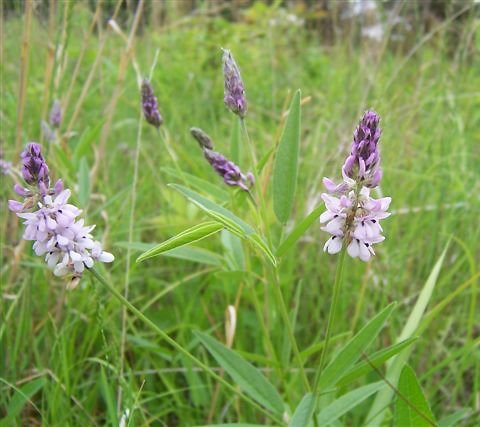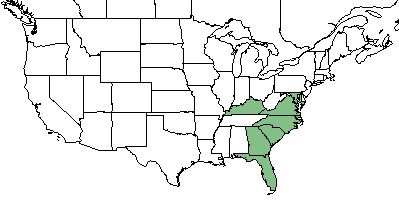Difference between revisions of "Orbexilum pedunculatum"
(→Ecology) |
(→Phenology) |
||
| Line 37: | Line 37: | ||
<!--Natural communities, human disturbed habitats, topography, hydrology, soils, light, fire regime requirements for removal of competition, etc.--> | <!--Natural communities, human disturbed habitats, topography, hydrology, soils, light, fire regime requirements for removal of competition, etc.--> | ||
===Phenology=== | ===Phenology=== | ||
| − | + | ''O. pedunculatum'' has been observed flowering in May and August, with peak inflorescence in June.<ref name= "Pan Flora"> Nelson, G. PanFlora: Plant data for the eastern United States with emphasis on the Southeastern Coastal Plains, Florida, and the Florida Panhandle. www.gilnelson.com/PanFlora/ Accessed: 24 MAY 2018</ref> | |
<!--Timing off flowering, fruiting, seed dispersal, and environmental triggers. Cite PanFlora website if appropriate: http://www.gilnelson.com/PanFlora/ --> | <!--Timing off flowering, fruiting, seed dispersal, and environmental triggers. Cite PanFlora website if appropriate: http://www.gilnelson.com/PanFlora/ --> | ||
<!--===Seed dispersal===--> | <!--===Seed dispersal===--> | ||
Revision as of 15:25, 6 November 2018
Common Names: Sampson's snakeroot [1]
| Orbexilum pedunculatum | |
|---|---|

| |
| Photo by John Hilty at IllinoisWildflowers.info | |
| Scientific classification | |
| Kingdom: | Plantae |
| Division: | Magnoliophyta - Flowering plants |
| Class: | Magnoliopsida - Dicots |
| Order: | Fabales |
| Family: | Fabaceae |
| Genus: | Orbexilum |
| Species: | O. pedunculatum |
| Binomial name | |
| Orbexilum pedunculatum Miller | |

| |
| Natural range of Orbexilum pedunculatum from USDA NRCS Plants Database. | |
Contents
Taxonomic Notes
Synonym: none
Variety: Psoralea psoralioides (Walter) Cory var. elandulosa (Elliott) F.L. Freeman
Description
O pendunculatum is a perennial forb/herb of the Fabaceae family native to North America. [1]
Distribution
O pendunculatum is found in Florida, Georgia, South Carolina, North Carolina, Virginia, Maryland, and Kentucky. [1]
Ecology
Habitat
Open woodlands are the ideal habit for O pedunculatum. [2]
Specimens have been taken from habitats that include dry loamy sands, pinewoods, moist loamy sand of pine flatwoods, longleaf pine wiregrass savanna, oak woodland, oak pine on sandstone, low ridges, open woody area, full sun, prairie, open field, and boggy meadow. [3]
Phenology
O. pedunculatum has been observed flowering in May and August, with peak inflorescence in June.[4]
Conservation and Management
Cultivation and restoration
Photo Gallery
References and notes
- ↑ 1.0 1.1 1.2 USDA Plant Database
- ↑ Weakley, A. S. (2015). Flora of the Southern and Mid-Atlantic States. Chapel Hill, NC, University of North Carolina Herbarium.
- ↑ URL: http://herbarium.bio.fsu.edu. Last accessed: June 2018. Collectors: Loran C. Anderson, R.K. Godfrey,Norlan C. Henderson, R.A. Norris, R. Komarek, Rodie White, John B. Nelson, W. M. Whitten, Michael O. Moore, L. Gawin, J. Schmidt, Wilson Baker, Nancy Craft Colie, LK Kirkman, Lynn Hill, Richard Carter, M. Darst, A. Gholson, E L Stone, Sidney McDaiel, Michael B. Brooks, R. Kral, R.M. Kriebel, D. Demaree, Roomie Wilson, Clarke Hudson, D. S. Correll, Helen B. Correll, Samuel B. Jones, K E Blum, R.L. Wilbur, P.L. Redfearn, GF Baker, R.E. Shanks, A. J. Sharp, A. Clebsch, L.H. Chinners, R. Vorris, C.L. Lundell, Amelia Lundell, John W. Thierest, H. R. Reed, Raymond Athey,Arthur Stanley Pease, Scott McCoy, M. Morgan, H.E. Ahles, C. R. Bell, J. Kevin England, Brian R. Keener, William B. Fox, R.L. Wilbur, B. L. Turner, B.E> Smith, R. B. Carr. States and counties: Florida (Liberty, Franklin, Wakulla, Leon), Georgia (Thomas, Grady, Brooks, Liberty, Elbert, Lowndes, Decatur, Lee, Stanley, Emanual, Tift), Alabama (Marshall, Russell, Talladega, Cullman, Marengo) South Carolina (Barnwell, Richland, Darlington, Horry) Tennessee (Grundy, Coffee, Pickett) Louisiana (Vernon, Tangipahoa, Ouachita, Acadia) Mississippi (Clay, Forrest, Newton, Pearl River) Indiana (Jackson, Knox) Arkansas (Garland, Ashley, Conway, Marion, Saline) Texas (Wood, Smith, Upsur) Missouri (St. Clair, Carter, Greene) Kentucky (Trigg, Crittenden) Virginia (Sussex) North Carolina (Halifax, Warren, Scotland, Cumberland, Washington, Martin, Granville, Johnston, Wilson, Bladen, Orange, Franklin)
- ↑ Nelson, G. PanFlora: Plant data for the eastern United States with emphasis on the Southeastern Coastal Plains, Florida, and the Florida Panhandle. www.gilnelson.com/PanFlora/ Accessed: 24 MAY 2018